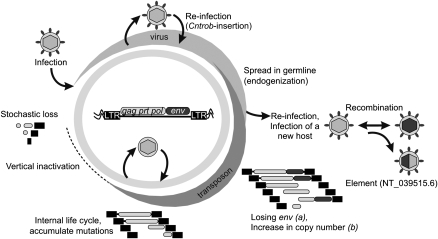Figure 6.
Model of RnERV-K8e life cycle. An infectious retrovirus integrates into the germline of a host organism and is transmitted vertically. Such ERV may retain the capability to produce infectious particles with occasional re-infection or horizontal transmission. We propose that the Cntrob-RnERV-K8e insertion is a potential reinfection event. In addition to reinfection, the retrovirus has the potential to infect a new host and recombine with related ERVs. Emergence of a new ERV family, represented by NT_039515.6, might be the result of a transmission event between the rat and mouse hosts (Fig. 2A,B). Upon endogenization the infectivity is usually decreased, with eventual loss of the env gene and/or the plasma membrane targeting function (a). In addition, retrotransposition efficiency and copy number might dramatically increase (b). Considering the env–independent, but low retrotranspositional activity of Rat-ρ, the endogenization status of RnERV-K8e is proposed to be between steps a and b. The endogenized virus could finish its life cycle as a real retrotransposon. Strikingly, the exogenous and endogenous life cycles of the same retrovirus might coexist, giving rise to subfamilies (Ribet et al. 2008a).

